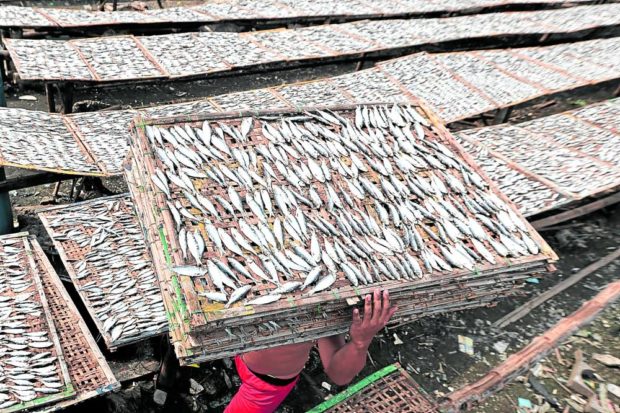
ADDED EXPENSE | Fishermen process dried fish at a fishing village in Rosario, Cavite. Fish growers have complained about a shortage in feeds that has led to an increase in their production costs. (Photo by GRIG C. MONTEGRANDE / Philippine Daisly Inc
MANILA, Philippines — Local producers are continuing to reel from the high cost of raising fish like bangus and tilapia due to a shortage in feeds, in addition to another problem: the lack of fish fry.
According to various fish farm groups, their feed conversion ratio (FCR) — or the ratio of the number of kilogran of feeds needed to produce a kilo of fish—has gone up tremendously.
David Villaluz, chair of Philippine Association of Fish Producers Inc., said that in Visayas farms, a kilogram of bangus used to consume 1.2 to 1.6 kg of feeds to grow large enough to be harvested. The FCR has since increased to 1.8 to 2 kilos of fish feeds.
“A higher FCR translates to a P10 per kilo increase in production cost. Add the P4 per kilo increase in feeds cost [and] the total increase in production cost is P14. Small fish farms may not be able to bear these additional costs,” he said.
Higher than ever
The problem has also affected nearly half of fish pond operators in Mindanao, according to Joseph Anthony Lanzar, president of Malalag Bay Fish Cage Operators and Fisherfolks Association.
Their FCR, Lanzar said, was now “higher than ever” at 2.4 to 2.6. On top of this, they were also experiencing a shortage of fish fry. “The fry being shipped from Indonesia is often of low quality,” he added.
To alleviate the feeds shortage, the aquaculture sector asked the government in April to allow them to bring in processed animal proteins (PAPs) from countries hit by the African swine fever (ASF).
The government had imposed a temporary ban in 2019, which it lifted in August, but only for aquatic feed use.
But last week, the National Federation of Hog Farmers Inc. reiterated its appeal for a ban on PAP importation to avoid hampering the ongoing fight against ASF, particularly now that the hog sector has been registering positive growth.
According to the group, it was not against importing PAP as long as it came from countries that were free of ASF.
Central hatchery needed
Fish farmers groups have also proposed the implementation of the Brood Stock Project to lower the cost of fish farming in the country.
“We need a central hatchery to provide adequate fry to our growers. This way, we can stop our dependence on Indonesia. We are not getting consistent fry quality from them. It can range from Class A to Class C fry, depending on the seller,” Villaluz said.
“This is also where Indonesia got that idea because of the Seafdec (Southeast Asian Fisheries Development Center) but they were the first to implement it,” he added.
RELATED STORIES
Tilapia worth P3M lost to fish kill in Taal Lake
Pamalakaya tells Bongbong Marcos to skip fish importation
Marcos urged to create fisheries department